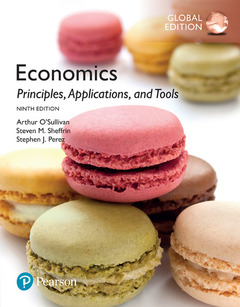Description
Economics: Principles, Applications, and Tools, Global Edition (9th Ed.)
Authors: O'Sullivan Arthur, Sheffrin Steven, Perez Stephen
Language: English
Subject for Economics: Principles, Applications, and Tools, Global...:
79.21 €
In Print (Delivery period: 14 days).
Add to cart768 p. · 22x27.5 cm · Paperback
Description
/li>Contents
/li>Comment
/li>
For courses in the Principles of Economics
Introduces Students to the Basic Concepts of Economics with Timely, Engaging Stories and Applications
Students enter their first economics course hoping to gain a better understanding of the world around them, but often leave with their questions unanswered. Economics: Principles, Applications, and Tools is built upon the author?s philosophy of using basic concepts of economics to explain a wide variety of timely, engaging, real-world economic applications.
The 9th Edition incorporates updated figures and data, while also emphasising current topics of interest?including the severe economic downturn of recent years and the latest developments in economic thinking. It also includes newly refined Learning Objectives that introduce the concepts explored in each chapter, along with new applications and chapter-opening stories related to the most up-to-date developments in both macroeconomics and microeconomics.
- I. Introduction and Key Principles
- 1. Introduction: What Is Economics?
- 2. The Key Principles of Economics
- 3. Exchange and Markets
- 4. Demand, Supply, and Market Equilibrium
- II. The Basic Concepts in Macroeconomics
- 5. Measuring a Nation’s Production and Income
- 6. Unemployment and Inflation
- III. The Economy in the Long Run
- 7. The Economy at Full Employment
- 8. Why Do Economies Grow?
- IV. Economic Fluctuations and Fiscal Policy
- 9. Aggregate Demand and Aggregate Supply
- 10. Fiscal Policy
- 11. The Income-Expenditure Model
- 12. Investment and Financial Markets
- V. Money, Banking, and Monetary Policy
- 13. Money and the Banking System
- 14. The Federal Reserve and Monetary Policy
- VI. Inflation, Unemployment, and Economic Policy
- 15. Modern Macroeconomics: From the Short Run to the Long Run
- 16. The Dynamics of Inflation and Unemployment
- 17. Macroeconomic Policy Debates
- VII. The International Economy
- 18. International Trade and Public Policy
- 19. The World of International Finance
- VIII. A Closer Look at Demand and Supply
- 20. Elasticity: A Measure of Responsiveness
- 21. Market Efficiency and Government Intervention
- 22. Consumer Choice: Utility Theory and Insights from Neuroscience
- IX. Market Structures and Pricing
- 23. Production Technology and Cost
- 24. Perfect Competition
- 25. Monopoly and Price Discrimination
- 26. Market Entry and Monopolistic Competition
- 27. Oligopoly and Strategic Behavior
- 28. Controlling Market Power: Antitrust and Regulation
- X. Externalities and Information
- 29. Imperfect Information: Adverse Selection and Moral Hazard
- 30. Public Goods and Public Choice
- 31. External Costs and Environmental Policy
- XI. The Labor Market and Income Distribution
- 32. The Labor Market and the Distribution of Income
This title is a Pearson Global Edition. The Editorial team at Pearson has worked closely with educators around the world to include content which is especially relevant to students outside the United States.
About the Book
Expanded Coverage to Reflect Economic Changes and Developments
- UPDATED! Incorporates and reflects the sweeping changes that global economies have experienced following a severe economic downturn.
- UPDATED! Reflects the latest exciting developments in economic thinking, making these developments accessible to new students of economics.
- NEW! Chapter 6 discusses whether the recent major recession permanently affected labor force participation.
- NEW! Chapter 8 discusses the position of pessimists who think that technological progress has slowed down, as well as influential controlled experiments in economic policy.
- NEW! Chapter 13 discusses the rationale and application of “stress tests” as a new tool for financial regulation.
- NEW! Chapter 14 introduces Janet Yellen, the new Chair of the Federal Reserve, including a discussion of her prior experience before assuming her current role.
- UPDATED! Revised and expanded discussion of the euro in Chapter 19 reflects the serious challenges now facing the European Monetary Union, particularly in the case of Greece.
- NEW! Several new applications and chapter-opening stories emphasize the widespread relevance of economic analysis, including discussion of:
- Housing prices in Cuba (Chapter 1)
- Property rights in urban slums (Chapter 3)
- The effects of winds from the Sahara Desert on the price of chocolate (Chapter 4)
- Links between unemployment and unemployment insurance (Chapter 6)
- How the government promotes high levels of savings i




